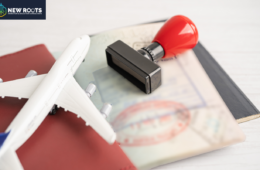
Family Visa Australia – Reunite with Your Loved Ones
Australia is known for its strong family values and offers various Family Visas to help reunite families. If you have relatives who are Australian citizens, permanent residents, or eligible New Zealand citizens, you may be eligible to apply for a Family Visa to live, work, and study in Australia.
In this guide, we’ll explore the different types of Family Visas, eligibility criteria, application steps, and how New Roots can assist in making your journey smooth and successful.
What is a Family Visa?
A Family Visa allows non-Australian family members to join their relatives in Australia for temporary or permanent stays. These visas cater to various relationships, including spouses, parents, children, and dependent relatives.
The Australian government recognizes the importance of family unity and offers several visa options based on your specific relationship with your Australian sponsor.
Types of Family Visas in Australia
Australia provides different categories of Family Visas depending on the nature of the relationship:
1. Partner Visas
For spouses or de facto partners of Australian citizens, permanent residents, or eligible New Zealand citizens:
- Partner Visa (Subclass 820/801 & Subclass 309/100) – Temporary and permanent visa options for spouses and de facto partners.
- Prospective Marriage Visa (Subclass 300) – For fiancés intending to marry an Australian citizen or permanent resident.
2. Parent Visas
For parents of Australian citizens or permanent residents who wish to join their children in Australia:
- Contributory Parent Visa (Subclass 143 & 173) – Faster processing but higher application costs.
- Parent Visa (Subclass 103) – A lower-cost option with a longer waiting period.
- Aged Parent Visa (Subclass 804) – For older parents meeting age and dependency criteria.
3. Child Visas
For children of Australian citizens, permanent residents, or eligible New Zealand citizens:
- Child Visa (Subclass 101 & 802) – For dependent children under 18 (or over 18 under specific circumstances).
- Adoption Visa (Subclass 102) – For children adopted by Australian citizens or permanent residents.
- Orphan Relative Visa (Subclass 117 & 837) – For children with no parents but with Australian relatives who can sponsor them.
4. Other Family Visas
For other dependent family members:
- Remaining Relative Visa (Subclass 115 & 835) – For individuals whose only family members reside in Australia.
- Aged Dependent Relative Visa (Subclass 114 & 838) – For older relatives financially dependent on their Australian relatives.
- Carer Visa (Subclass 116 & 836) – For individuals providing essential care to a relative with a long-term illness or disability.
Eligibility Criteria for a Family Visa
The eligibility for a Family Visa depends on the specific visa subclass. However, common requirements include:
- Sponsor Requirement – A sponsor must be an Australian citizen, permanent resident, or eligible New Zealand citizen.
- Relationship Proof – Valid documents proving a genuine relationship (e.g., birth certificates, marriage certificates, dependency documents).
- Health and Character Checks – All applicants must pass health and police checks.
- Financial Support – Some visas require proof that the applicant or sponsor can support the family member financially.
- Age Restrictions – Certain visas, such as the Child Visa, have age-related conditions.
How to Apply for a Family Visa?
Applying for a Family Visa involves multiple steps. Here’s a general guide:
Step 1: Determine Eligibility
Identify the correct visa subclass and check if you and your sponsor meet the requirements.
Step 2: Gather Necessary Documents
- Passport and identity documents
- Relationship proof (marriage/birth certificates, financial statements)
- Health and character clearances
- Financial support documents (if required)
Step 3: Submit the Visa Application
Lodge your application online through the Department of Home Affairs or via a paper application where applicable.
Step 4: Pay the Visa Fee
Each Family Visa has a different processing fee. Check the latest visa pricing before submitting your application.
Step 5: Biometrics and Health Examinations
Some applicants must complete health examinations and provide biometric details.
Step 6: Await Processing and Decision
Visa processing times vary depending on the visa type. Temporary visas may be processed faster, while permanent visas may take years.
Step 7: Receive Visa Approval
Once approved, you will receive a visa grant notice outlining your visa conditions.
Processing Time and Costs
The processing time for Family Visas varies significantly:
- Partner Visas – 12 to 24 months.
- Parent Visas – Contributory Parent Visas take 3-5 years, while non-contributory visas can take 30+ years.
- Child Visas – 6 to 12 months.
- Other Family Visas – Can take several years due to high demand.
Visa costs also vary based on the visa type. Partner Visas generally cost around AUD 8,000, while Contributory Parent Visas can exceed AUD 47,000.
Why Choose New Roots for Your Family Visa Application?
Navigating the Family Visa application process can be complex and time-consuming. At New Roots, we provide expert visa assistance to ensure that your application meets all legal and documentation requirements. Our services include:
- Personalized Visa Consultation – Guidance on selecting the best visa option for your family situation.
- Documentation Assistance – Helping you compile all necessary documents.
- Application Submission Support – Ensuring error-free submission to avoid unnecessary delays.
- Ongoing Case Updates – Keeping you informed about your application progress.
Final Thoughts
The Family Visa is an excellent opportunity for reuniting with loved ones in Australia. Whether you’re applying for a Partner Visa, Parent Visa, Child Visa, or another Family Visa, understanding the requirements and preparing a strong application is crucial for success.
If you need expert guidance for your Family Visa application, New Roots is here to help. Contact us today for professional visa assistance!





